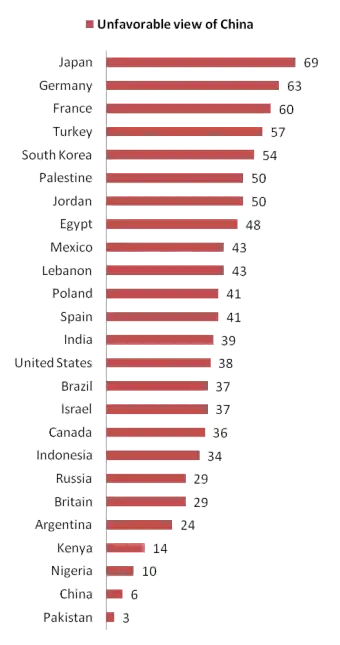Anti-Chinese sentiment in Japan
Anti-Chinese sentiment has been present in Japan since at least the Tokugawa period.
History
Tokugawa period
Beginning in the Tokugawa period (1600 to 1868), Japan left a prolonged period of civil war and began to prosper as a unified and stable state.[1] This period saw an attempt to remove foreign influences on Japanese Culture, including the influence of Chinese culture. During this time, Japan maintained a policy of self-isolation, leading to the further development of its culture with little foreign influence. A rise in national self-respect at this time resulted in Japan viewing itself as the centre of a "civilised world surrounded by barbarians."[2]
A key proponent of these movements and schools of thought was the cultural movement and branch of scholarship known as kokugaku (国学), translating literally as "National Studies", and translated commonly as "Japanese Studies". Kokugaku aimed through its practitioners (known as kokugakushu) to distinguish between a perception of genuine Japanese culture in contrast to what was considered as foreign culture,[3] with the resulting goal being to revert Japanese culture to one devoid of foreign influence.
Practitioners of kokugaku placed particular importance on Shinto,[3] Japan's indigenous religion,[4] seen as a bulwark against foreign, and especially Confucian and Buddhist, influences. However, by the time kokugaku developed, Shinto had already been heavily influenced by both Confucianism and Buddhism;[5] due to this, the net effect of kokugaku scholarship and its achievements is debated.
Empire of Japan
Following the Meiji Restoration and the abandonment of its self isolationist policy, Japan pursued a policy of aggressive Westernisation and industrialisation in effort to match the progress of Western nations. At the same time as this, China had begun to sink into a state of deep dysfunction, and was perceived as a declining power by many, including Japan, which increasingly lost respect for China. Increasingly Sinophobic sentiment within Japan contributed to a number of atrocities committed by Imperial Japanese soldiers against the Chinese during World War II, most notably the Nanking Massacre.
The Second Sino-Japanese War (1937-1945) also compounded on this, resulting in the loss of life of more than 20 million mostly civilian Chinese people. The property loss suffered by the Chinese was valued at US$383 billion at the currency exchange rate in July 1937, roughly 50 times the GDP of Japan at that time (US$7.7 billion).[6]
Post World War II

Negative views of China are especially strong in Japan, Germany, and France.

Following the end of the World War II, openly Sinophobic sentiments were stifled and became taboo in mainstream Japanese media, despite the opposing positions taken by Japan and the People's Republic of China in the Cold War. Use of the formerly common word Shina (支那) (lit., "China") has all but disappeared except in a handful of cases, such as the Japanese name for "South China Sea" and an alternative term for ramen.
Following the Cold War, there was little contact between Japan and the People's Republic of China in the ensuing decades, and little discussion of China until the relationship between the countries was normalised in 1972, following a surge of interest within Japan about its neighbour. China renounced reparations for the Second World War, partly to avoid appearing less generous than Taiwan — which had earlier done the same — and to strengthen its position against the Soviet Union. The response was of considerable gratitude and goodwill in Japan, with Sinophobia confined to an anti-communism. Public animosity toward the People's Republic of China was minimal compared to the public animosity held against the Soviet Union, and a friendly mood prevailed.[8] Improvements were also seen in social attitudes toward ethnic Chinese residents of Japan, along with other minorities such as Zainichi Koreans and the Ainu people.
However, since 2000, Japan has seen a gradual resurgence of anti-Chinese sentiments, coupled with the effects of an increasingly tense political relationship between Japan and the People's Republic of China. Many Japanese believe that China is using the issue of the countries' strained history, such as the Japanese history textbook controversies and official visits to the Yasukuni Shrine, both as a diplomatic card and to make Japan a scapegoat in domestic politics.[9] The anti-Japanese riots in the spring of 2005 are cited as raising tensions within China and fears within the Japanese public of China. Many Japanese nationalist groups, such as Ganbare Nippon and Zaitokukai, are anti-Chinese, with data from the Pew Global Attitude Project (2008) showing that 85% of Japanese people surveyed held unfavourable views of China, and that 73% held unfavourable views of Chinese people.
See also
References
- Tokugawa Period. BookRags. Retrieved on 2008-08-24.
- Kanji Nishio II. Japan's Identity: Is Asia One? Is Japan Part of the East? Archived February 12, 2009, at the Wayback Machine Japan Forum on International Relations. Retrieved on 2008-08-24.
- Tokugawa Enlightenment Archived May 27, 2010, at the Wayback Machine
- Shinto. Japan-guide.com. Retrieved on 2008-08-24.
- Ng, Wai-ming. The I Ching in the Shinto Thought of Tokugawa Japan Archived 2017-12-12 at the Wayback Machine. University of Hawaii Press (1998). Retrieved on 2008-08-24.
- "BBC - History - World Wars: Nuclear Power: The End of the War Against Japan". Retrieved 28 March 2016.
- "Home - Indicators Database - Pew Research Center". Pew Research Center's Global Attitudes Project. 22 April 2010. Retrieved 28 March 2016.
- "asahi.com : English". Retrieved 28 March 2016.
- Matthew Forney, "Why China Loves to Hate Japan". Time Magazine, December 10, 2005. http://www.time.com/time/world/article/0,8599,1139759,00.html, accessed 1 June 2008
